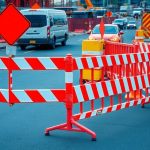Pros of Installing Speed Humps
Reduces Speeding and Improves Safety
Speed humps are an effective way to reduce speeding and improve safety on residential streets. By forcing drivers to slow down, speed humps can prevent accidents and reduce the severity of any collisions that do occur. Additionally, speed humps can make streets safer for pedestrians and cyclists, who are often vulnerable to accidents caused by speeding drivers. However, it is important to note that speed humps can also be a nuisance for some drivers, who may find them uncomfortable or inconvenient to navigate. Additionally, speed humps can increase noise pollution and may cause wear and tear on vehicles if not properly maintained.
Encourages Pedestrian and Bicyclist Safety
Speed humps can also encourage pedestrian and bicyclist safety in Dallas. By slowing down traffic, drivers are more likely to be aware of their surroundings and take extra precautions when sharing the road with pedestrians and bicyclists. This can lead to a decrease in accidents and injuries, making the streets safer for everyone. Additionally, speed humps can encourage more people to walk or bike instead of driving, which can have positive impacts on both public health and the environment. However, it is important to note that speed humps should not be relied upon as the sole solution for pedestrian and bicyclist safety, and other measures such as crosswalks and bike lanes should also be implemented.
Cost-Effective Solution
Speed humps are a cost-effective solution for traffic calming in Dallas. Compared to other traffic calming measures such as roundabouts or traffic circles, speed humps are relatively inexpensive to install and maintain. Additionally, speed humps can be easily removed or relocated if necessary, making them a flexible option for addressing changing traffic patterns. However, it is important to note that the cost-effectiveness of speed humps may vary depending on the specific location and traffic conditions. A thorough analysis of the costs and benefits should be conducted before implementing speed humps as a traffic calming measure.
Easy to Install and Maintain
One of the biggest advantages of speed humps is that they are relatively easy to install and maintain. Unlike other traffic calming measures, such as roundabouts or chicanes, speed humps can be installed quickly and with minimal disruption to traffic. They also require very little maintenance once they are in place. In fact, most speed humps only need to be inspected once or twice a year to ensure that they are still in good condition. This makes them a cost-effective solution for cities like Dallas that are looking to improve road safety without breaking the bank.
Can Improve Property Values
Speed humps can also have a positive impact on property values. By reducing the speed of vehicles in residential areas, speed humps can make neighborhoods safer and more desirable places to live. This can lead to increased demand for homes in the area, which can drive up property values. Additionally, the presence of speed humps can signal to potential buyers that the community is committed to safety and quality of life, which can be a selling point for homeowners. However, it is important to note that the impact on property values may vary depending on the specific location and context of the speed humps.
Cons of Installing Speed Humps in Dallas
Can Increase Noise Pollution
While speed humps can be effective in reducing speeding and improving safety on residential streets, they can also contribute to an increase in noise pollution. As vehicles slow down and then accelerate over the humps, they can create loud and disruptive sounds, especially for those living near the humps. Additionally, emergency vehicles may also experience delays and increased noise as they navigate over the humps. It is important for city officials to consider the potential noise impact on residents before installing speed humps and to explore alternative traffic calming measures that may be less disruptive.
May Cause Vehicle Damage
One of the major concerns with installing speed humps is the potential damage they may cause to vehicles. If a driver is not aware of the speed hump or is driving too fast, they may hit the hump at a high speed, causing damage to their vehicle’s suspension or tires. Additionally, emergency vehicles such as ambulances and fire trucks may also experience difficulty navigating over speed humps, potentially delaying response times in emergency situations. It is important for city officials to carefully consider the placement and design of speed humps to minimize the risk of vehicle damage while still effectively slowing down traffic.
Can Increase Response Time for Emergency Vehicles
One of the major concerns with installing speed humps in Dallas is that they can increase response time for emergency vehicles. Speed humps can slow down emergency vehicles, which can be dangerous in situations where every second counts. However, there are ways to mitigate this issue. For example, emergency vehicles can be equipped with technology that allows them to automatically lower their suspension when approaching speed humps, allowing them to maintain their speed without damaging the vehicle or compromising safety. Additionally, speed humps can be strategically placed to minimize their impact on emergency response times. Overall, while this is a valid concern, it is not a reason to completely dismiss the use of speed humps in Dallas.
May Cause Traffic Congestion
While speed humps are effective in slowing down traffic, they can also cause traffic congestion. Drivers may slow down significantly or even come to a complete stop to navigate over the hump, causing a backup of cars behind them. This can be especially problematic during rush hour or in areas with high traffic volume. Additionally, emergency vehicles such as ambulances and fire trucks may have difficulty navigating over speed humps, potentially delaying response times in emergency situations. It is important to carefully consider the placement and frequency of speed humps to minimize the potential for traffic congestion.
May Not Be Effective in All Situations
While speed humps have been proven to be effective in reducing speeding in many areas, they may not be the best solution for all situations. For example, in areas where emergency vehicles need to respond quickly, speed humps can slow down response times. Additionally, in areas with heavy truck traffic, speed humps can cause damage to vehicles and increase noise pollution. It’s important to carefully consider the specific needs and characteristics of each location before deciding whether or not to install speed humps.
Next steps: If you are considering the installation of speed humps in Dallas, it is important to carefully weigh the pros and cons. While speed humps can be effective in reducing speeding and improving safety, they can also have drawbacks such as increased noise and potential damage to vehicles. To learn more about the pros and cons of speed humps and speed bumps Dallas Texas, visit Unimat-traffic.com. Unimat Traffic USA offers a range of traffic calming solutions, including speed humps, that can help improve safety on Dallas roadways. Contact them today for more information about their products and services.
Traditional designs and their limitations
Traditional speed bumps and humps have been used for decades to slow down traffic in residential areas, school zones, and parking lots. However, these designs have several limitations. Firstly, they can cause discomfort and even damage to vehicles if drivers do not slow down enough. Secondly, emergency vehicles such as ambulances and fire trucks may have difficulty navigating over them, potentially delaying response times. Lastly, traditional speed bumps and humps can be visually unappealing and may not fit in with the aesthetic of certain neighborhoods. As a result, there has been a push for more innovative designs that address these limitations while still effectively slowing down traffic.
Innovative Designs for Speed Bumps
Flat-top speed bumps
Flat-top speed bumps are a newer design that has gained popularity in recent years. Unlike traditional speed bumps, which have a rounded shape, flat-top speed bumps have a flat surface with a gradual incline and decline on either side. This design allows for a smoother ride for vehicles, reducing the risk of damage to cars and making them more comfortable for passengers. Additionally, flat-top speed bumps are often painted with bright colors or reflective materials to increase visibility and alert drivers to slow down. These features make flat-top speed bumps a safer and more effective option for controlling speed in areas where traditional speed bumps may not be suitable.
Rolling speed bumps
Rolling speed bumps are a new and innovative design that aims to reduce the discomfort and noise caused by traditional speed bumps. These speed bumps are made of a series of small rollers that are placed on the road surface. When a vehicle passes over them, the rollers rotate, creating a gentle and smooth ride. Rolling speed bumps are designed to slow down traffic without causing damage to vehicles or discomfort to drivers and passengers. They are also more environmentally friendly than traditional speed bumps, as they do not require any additional materials or energy to produce. Rolling speed bumps are becoming increasingly popular in urban areas, where traffic calming measures are needed to improve safety and reduce congestion.
Sinusoidal speed bumps
Sinusoidal speed bumps are a relatively new type of speed bump that is gaining popularity due to its unique design. Unlike traditional speed bumps, sinusoidal speed bumps are designed with a series of rounded bumps that are spaced out evenly. This design allows for a smoother ride over the speed bump, reducing the impact on vehicles and passengers. Additionally, the sinusoidal design allows for a reduction in speed without the need for a complete stop, making it a more efficient option for traffic calming. These speed bumps are also designed to be more visually appealing, with a sleek and modern look that blends in with the surrounding environment. Overall, sinusoidal speed bumps offer a more comfortable and effective solution for slowing down traffic in residential areas and parking lots.
Speed cushions
Speed cushions are a type of traffic calming measure that are designed to slow down vehicles without causing discomfort to emergency vehicles or buses. These cushions are typically made of rubber or plastic and are placed in a staggered pattern across the road. The cushions are designed to be wide enough to force drivers to slow down, but narrow enough to allow emergency vehicles and buses to straddle them without slowing down. Speed cushions have been shown to be effective in reducing speeds and improving safety on residential streets. However, some drivers may find them to be a nuisance and may try to avoid them by driving on the wrong side of the road.
Innovative Designs for Speed Humps
Split speed humps
Split speed humps are a variation of the traditional speed hump design that is gaining popularity in many cities. These humps are split into two sections, with a gap in the middle that allows vehicles with a longer wheelbase, such as buses and emergency vehicles, to pass over them without having to slow down. This design helps to reduce traffic congestion and delays, while still maintaining the safety benefits of traditional speed humps. Split speed humps are also more visually appealing than traditional speed humps, as they can be painted with different colors and patterns to blend in with the surrounding environment.
Inverted speed humps
Inverted speed humps are a relatively new design that has gained popularity in recent years. Unlike traditional speed humps that are raised, inverted speed humps are recessed into the road surface. This design allows for smoother and faster travel for emergency vehicles, buses, and other vehicles that require a smoother ride. Inverted speed humps also reduce noise pollution and are less visually obtrusive than traditional speed humps. Additionally, they are less likely to damage vehicles that may bottom out on traditional speed humps. Overall, inverted speed humps are a promising innovation in traffic calming measures.
Variable height speed humps
Variable height speed humps are a newer innovation in traffic calming measures. These speed humps are designed to adjust their height based on the speed of the approaching vehicle. When a vehicle is traveling at a higher speed, the hump will rise to a greater height, causing the driver to slow down. However, if a vehicle is traveling at a slower speed, the hump will remain at a lower height, allowing for a smoother ride. This technology is particularly useful in areas where speed limits vary or where emergency vehicles need to travel at higher speeds. Variable height speed humps are also more environmentally friendly, as they reduce the amount of noise pollution caused by traditional speed humps.
Speed tables
Speed tables are a type of traffic calming measure that are similar to speed humps, but with a longer and flatter surface. They are typically used in areas where traffic needs to slow down, such as school zones or residential areas. Speed tables are designed to be more comfortable for drivers to pass over at a slower speed, as they have a gentler slope and a longer flat section. This makes them a popular choice for areas where emergency vehicles need to maintain a higher speed, as they can pass over the speed table without having to slow down as much as they would for a speed hump. Additionally, speed tables can be designed with landscaping or other aesthetic features to make them more visually appealing and blend in with the surrounding environment.
Benefits of Innovative Designs
Improved traffic flow
Improved traffic flow is a major concern for many cities and towns. Traditional speed bumps and humps can slow down traffic and cause congestion, especially during peak hours. However, innovative designs such as the sinusoidal speed hump and the speed cushion have been developed to address this issue. The sinusoidal speed hump is designed to allow vehicles to maintain a higher speed while still reducing speed overall. The speed cushion is a raised platform with gaps that allow emergency vehicles to pass through without slowing down. These designs not only improve traffic flow but also enhance safety on the roads.
Reduced noise pollution
Reduced noise pollution is a major concern for many communities, especially those located near busy roads or highways. Traditional speed bumps and humps can create loud and jarring noises as vehicles pass over them, which can be disruptive to nearby residents. However, innovative designs for speed bump rubber and humps have been developed to address this issue. For example, some speed bumps are designed with a series of smaller bumps that are spaced out, which can reduce the noise created by vehicles passing over them. Other designs incorporate materials that absorb sound, such as rubber or asphalt, to further reduce noise pollution. These innovative designs not only improve safety on the roads but also enhance the quality of life for nearby residents.
Enhanced safety for pedestrians and cyclists
Speed bumps and humps have been designed to enhance the safety of pedestrians and cyclists. These innovative designs are aimed at reducing the speed of vehicles and making drivers more aware of their surroundings. Some speed bumps and humps are designed with reflective materials, making them more visible at night. Others are designed to be wider and longer, allowing for a smoother ride for cyclists. Additionally, some speed bumps and humps are designed to be more gradual, reducing the impact on vehicles and making them less likely to cause damage. These enhanced safety features are crucial in areas with high foot and bike traffic, ensuring that everyone can travel safely.
Less wear and tear on vehicles
One of the major concerns with traditional speed bumps and humps is the wear and tear they can cause on vehicles. However, innovative designs have been developed to address this issue. For example, some speed bumps are now made with a more gradual incline and decline, which reduces the impact on vehicles and their suspension systems. Additionally, some speed humps are designed with a wider base and a gentler slope, which spreads out the weight of the vehicle and reduces the jarring effect. These new designs not only improve the driving experience for motorists, but also help to prolong the lifespan of their vehicles.
Conclusion
Summary of innovative designs
In summary, there are several innovative designs for speed bumps and humps that have been developed in recent years. These include modular speed bumps that can be easily installed and removed, rubber speed humps that are more durable and effective than traditional asphalt humps, and even solar-powered speed bumps that light up at night to increase visibility. Additionally, some designs incorporate features such as reflective markings or textured surfaces to further enhance their effectiveness. These innovative designs offer a range of options for traffic calming measures that can be tailored to specific needs and locations.
Future possibilities for speed bumps and humps
Future possibilities for speed bumps and humps are exciting and promising. One potential development is the use of smart technology to create speed bumps that can adjust their height and angle based on the speed of the approaching vehicle. This would allow for a smoother ride for drivers who are traveling at or below the speed limit, while still effectively slowing down those who are speeding. Additionally, there is potential for the integration of renewable energy sources into speed bumps and humps, such as solar panels or kinetic energy harvesting systems. This would not only make them more environmentally friendly, but also potentially generate energy to power nearby streetlights or other infrastructure. As technology continues to advance, the possibilities for innovative and effective speed bump and hump designs are endless.





